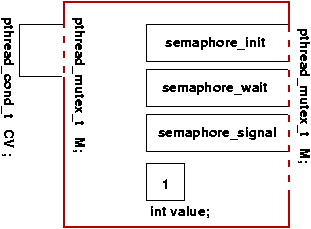| COP4610: Operating Systems &
Concurrent Programming |
up
↑ |
Semaphores, versus Mutexes & CVs
The POSIX thread synchronization objects, mutexes and condition variables,
are a more recent invention than some other synchronization mechanisms. Using
them, one can solve any problem that can be solved using other mechanisms.
Here, we show how they can be used to implement one of the earliest and best
known types of synchronization objects: semaphores.
Counting Semaphore
- A type of synchronization object
- Atomically counts available resources, and waits for resources to
become available
- Holds an integer value, called the count< which is initially
non-negative
- Has an associated queue of waiting procesess
- Operations:
-
decrement, also known as P, down, and
wait
s.count--;
if (s.count < 0) { enqueue and block this process }
-
increment, also known as V, up, post, and
signal
s.count++;
if (s.count <= 0) {dequeue and unblock one process waiting on this semaphore, if any }
This is just one of several published variants of counting semaphores. The
variants differ in such things as:
- whether the initial count can be negative
- whether the count can ever be negative
- whether additional operations are supported
For example, the specification of the Linux realtime semaphores API (based
on the POSIX specifications) carefully avoids dealing with negative
values:
Semaphores are counters for resources shared between threads. The basic
operations on semaphores are: increment the counter atomically, and wait
until the counter is non- null and decrement it atomically.
sem_init initializes the semaphore object pointed to by tially to value.
The pshared argument indicates whether the semaphore is local to the
current process (pshared is zero) or is to be shared between several
processes (pshared is not zero). LinuxThreads currently does not support
process-shared semaphores, thus sem_init always returns with error ENOSYS
if pshared is not zero.
sem_wait suspends the calling thread until the semaphore pointed to by
sem has non-zero count. It then atomically decreases the semaphore
count.
sem_trywait is a non-blocking variant of sem_wait. If the
semaphore pointed to by sem has non-zero count, the count is atomically
decreased and sem_trywait immediately returns 0. If the semaphore count is
zero, sem_trywait immediately returns with error EAGAIN.
sem_post atomically increases the count of the semaphore pointed to by
sem. This function never blocks and can safely be used in asynchronous
signal handlers.
Note that use of the name signal for the semaphore
increment operation, and also in the name pthread_cond_signal has no
connection with Unix signals. In this respect, it would be perhaps clearer if
we were using an object-oriented notation, like semaphore.signal.
Limited to functional notation, the POSIX semaphore API uses the terms
sem_wait and sem_post to avoid this confusion.
The name P is used traditionally for the semaphore wait
operation and the name V is used traditionally for the semaphore
signal operation, because these are the initial letters of the
corresponding words in the Dutch language, which is the native language of
the person (Edsgar Dijkstra) who wrote the definitive paper on
semaphores.
Implementation of Linux/POSIX Semaphore as Monitor, using Mutex &
CV
 |
typdef struct counting_semaphore {
pthread_mutex_t M;
pthread_cond_t CV;
int value;
} sem_t;
void semaphore_wait () {
pthread_mutex_lock (&S.M);
while (S.value == 0) pthread_cond_wait (&S.CV, &S.M);
S.value--;
pthread_mutex_unlock (&S.M);
void semaphore_signal () {
pthread_mutex_lock (&S.M);
S.value++ ;
if (S.value == 1) pthread_cond_signal (&S.CV);
pthread_mutex_unlock (&S.M);
}
|
Semaphores are normally implemented by the operating system, using
hardware instructions and other low-level building blocks. This example is
intended for pedagogical purposes only. It illustrates:
- that mutexes and CV's are as powerful as semaphores
- how to construct a monitor using a mutex and CV
- the difference between POSIX and counting semaphores
Whether the above provides FIFO service, is fair, etc. will depend
on the implementation of the condition variable and mutex, which in general
are not required to be fair.
By the way, the variation on semaphores implemented above does not allow
the semaphore to take on a negative value. Could you modify the code above to
support the model that allows negative semaphore values? How
much more difficult would it be? Would there be any functional
difference?
